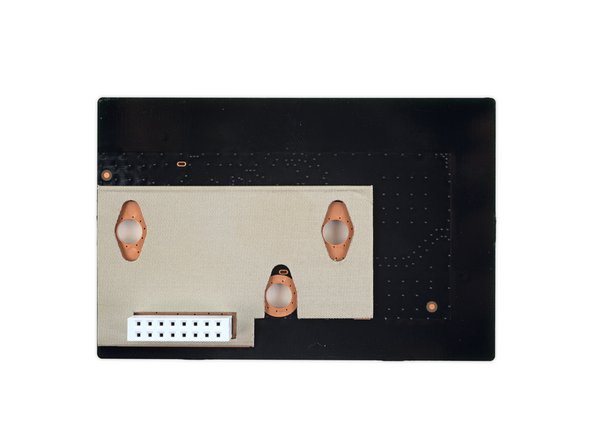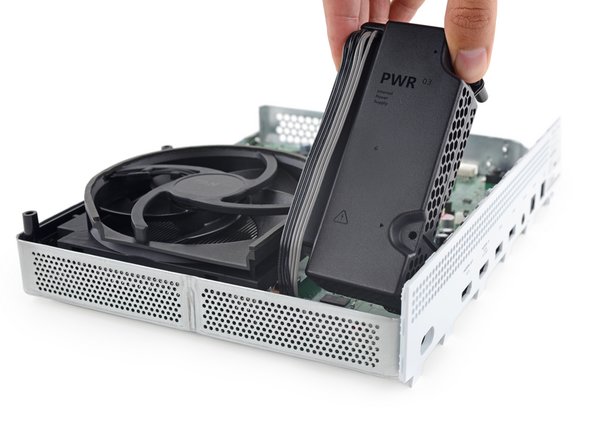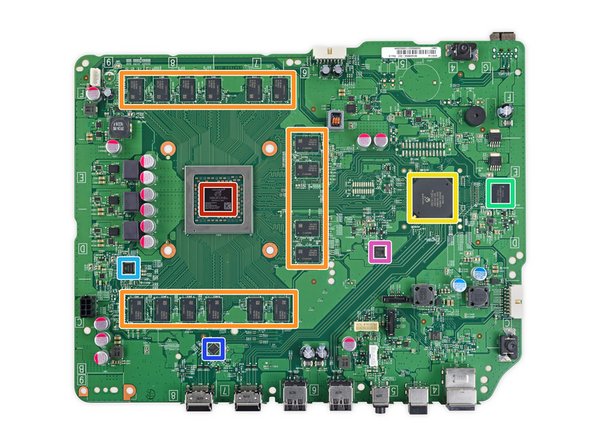Xbox One S Teardown
ID: 65572
Description: Today a new Xbox lands in our inbox, and that's...
Steps:
- You'd expect some differences from the Day One Edition Xbox One we tore down way back in 2013, and you'd be right. Here's what we know:
- Spec-bumped GPU supporting HDR10 along with the same AMD "Jaguar" 8-core SoC found in the original Xbox One.
- 2 TB of storage (500 GB and 1 TB configurations are coming)
- HDMI 2.0a connectivity with support for 4K video at 60 Hz
- Internal power supply
- IR blaster
- Fancy vertical stand (2 TB model only)
- Redesigned Xbox Wireless Controller
- Etched into the starboard side of the Xbox One S, we find a cute reminder that this console still hails from the other tech capital of the West Coast: "Hello from Seattle," home of the Microsoft brigade.
- Moving right along, we discover the Xbox One S is now identified as Model 1681.
- In a design decision that takes us back to consoles of old, this One features mechanical buttons in lieu of capacitive ones.
- Gamers with a toddler or wet-nosed pet know the pain of the ultra-sensitive power button on the original Xbox One.
- Around back, under the many vent holes we find:
- Power inlet
- HDMI out (left) and in (right)
- Two USB 3.0 ports (in addition to the one on the front)
- IR output, optical audio, and Ethernet ports
- What about my Kinect, you ask? You can apply for a "free" Kinect USB adapter—provided you already own a Kinect, an original Xbox One, and the Xbox One S.
- Those who buy a Kinect to go with their Xbox One S will have to purchase the $40 adapter separately.
- Our first act of teardown: tamper evident sticker removal. But no screws in sight, just the back of an immobile plastic clip. Bummer.
- We take a moment to reminisce about our old Xbox 360 Opening Tool, but decide our trusted iFixit Opening Tool would be of more use here.
- Make that opening tools—because popping that plastic "security" nub takes a little extra oomph.
- Do we like security clips? Not in a box. Not with a fox. Not in a house. Not with a mouse. We do not like them here nor there; we do not like them anywhere.
- After some intense prying, we successfully remove the bottom cover, revealing a metal interior case.
- These clips may be tough at first, but plastic is bound to bend or break, unlike a reusable screw. The next time you open your One S it may not clip back together...
- Some nostalgic green screws labeled F (for first?) free the primary assembly from the upper case.
- Remember when Xbox was black and green and not a Destiny bundle PS4?
- This One, more streamlined than its predecessor, doesn't feature any weird, afterthought components left out in the cold.
- All that's left in the PC/ABS case are some button covers and Sabic and Samsung logos—probably the plastic suppliers.
- Okay, is it just the teardown giddiness, or does this case vaguely resemble a Star Destroyer hangar?
- Lifting one metal midbody panel reveals a beautiful sight: such nice, sleek components that we are momentarily inclined to keep the cover off forever.
- Somebody call the Jackson 5, 'cause identifying these numbered and labeled components is easy as 01-02-03 (and 04).
- But wait—who's that we spy?
- Master Chief has arrived on a new world, this time to protect the optical disc drive bracket. Hopefully the Flood keeps out of this drive for good.
- Much like the RF board on the Xbox One, the front panel board of the Xbox One S detaches outward from the lower case.
- With the front panel board's EMI shield removed, we quickly spy a lone IC and some of its friends:
- MediaTek MT7632TUN (Likely a variation of MT7632 2x2 802.11n + Bluetooth 4.0 Module)
- Skyworks SKY13314-374LF GaAs SPDT Switch
- Sync switch for wireless controllers
- IR Blaster
- Power Switch
- Eject switch
- Next up on the teardown chopping block is the Wi-Fi board. After removing a few Torx screws, it comes quietly just like the front panel board before it.
- This is a nice incremental improvement over its location in the previous Xbox One—it makes for one less step to open the inner metal case.
- Wi-Fi is handled by a MediaTek MT7612UN (Likely a variation of MT7612U 2x2 802.11ac Wi-Fi Module)
- At this point, component removal is a bit of a hunt, so we extract some screws and see which component is freed first.
- Oddly enough, despite being labeled 04, the hard drive is the first component out.
- The labels are likely numbered according to assembly, rather than the disassembly.
- We find a
SamsungSeagate Spinpoint M9T ST2000LM003 2 TB 5400 RPM with 32 MB Cache SATA III 6.0 Gb/s hard drive. Try saying that ten times fast. - Sadly, hard drive replacements still void the warranty, and need some tricky formatting.
- The One S packs a sweet SATA III drive, but it may still be using the SATA II interface of the original Xbox One. You can always add an external hard drive though, thanks Microsoft!
- The next to go is number two: the optical drive—too easy! Master Chief is of course along for the ride.
- Here we have the artist formally known as a BD-ROM drive, courtesy of Philips and Lite-On Digital Solutions. The DG-6M5S model found in the Xbox One S is slightly different from the DG-6M1S found in the Xbox One, with the biggest upgrade being support for BD-UHD.
- We also snag a couple rubber bumpers. These probably help keep the high-speed optical drive from rattling us off our rockers.
- Now we come to the One S's hat trick (a.k.a. #03)—a smaller, newly-fanless, neatly-integrated power supply. Gone is that dangling anchor of yore.
- Welcome to the club, Xbox One.
- An external power supply is much easier to replace than an internal one. So let's hope Microsoft did their homework to mitigate that need!
- This power supply also accepts 100-240 V inputs, meaning you can take it pretty much anywhere there's a socket. Take that, Xbox One!
- The power supply connects with what PC gamers will instantly recognize as a perfectly ordinary, 6-pin PCIe connector.
- Things are heating up in the teardown room, but we can't extract the "Thermal System" just yet. So we lift the whole dang motherboard assembly out of the metal casing.
- A springy, X-shaped bracket secures the heat sink to the motherboard—a signature part we've seen in every Xbox since the original 360.
- The "X" is a bit fussy and takes some muscle, but some practiced prying with a flathead driver saves the day.
- With the component countdown nearly complete, it's time to extract part number 01: the thermal system.
- Out comes the system's single 120 mm fan—looking much like a PC case fan, but with some sculpting that's unique to the Xbox One's design.
- The standard Xbox One had a similarly robust cooling setup, possibly designed to avoid a repeat of the Xbox 360's billion dollar problem.
- The backup for the One S's biggest fan is an impressive aluminum heat sink and copper heat pipe set. Cool.
- Now on to our One true love, chips!
- X949211-001 DG4001FYG87IA (Includes 1.75 GHz AMD "Jaguar" 8-core CPU + overclocked 914 MHz AMD Radeon Graphics GPU)
- 16 x Samsung SEC 549 K4W4G1646E-BC1A 4 Gb (512 MB) "gDDR3" SDRAM (total of 16 x 512 MB = 8 GB)
- X861949-005 T6WD5XBG-0003 Southbridge I/O controller
- Toshiba THGBMFG6C1LBAIL 8 GB eMMC NAND flash
- ON Semiconductor NCP4205 (Likely an iteration of the NCP4204 Integrated Power Control IC found in the Xbox One) (probably CPU power phase PWM controller)
- Texas Instruments SN75DP159 6 Gb/s DP++ to HDMI retimer
- STMicroelectronics LDFPT 1 A LDO regulator
- And on the back of the motherboard...is not much really.
- Realtek RTL8111HM (Likely an iteration of the RTL8111 gigabit ethernet controller)
- Nuvoton ISD8104 2 W class AB audio amplifier (likely)
- Texas Instruments SN74LVC1G08 single 2-input AND gate
- Oh and that handy front-side USB port—which is on the opposite end and opposite side from its friends, poor guy.
- Bonus chips:
- STMicroelectronics LM339A quad voltage comparator
- Texas Instruments TPS51916 memory power controller
- Richtek RT9011-JGPQV 300 mA dual LDO regulator
- Monolithic Power Systems MP8757GL 7 A / 18 V synchronous step-down converter
- Monolithic Power Systems MP2161GJ 2 A / 6 V synchronous step-down converter
- ON Semiconductor CAT6243DCADJ 1 A LDO regulator
- Diodes Incorporated (formerly BCD Semiconductor) AP2127K-ADJTRG1 300 mA LDO regulator
- Now on to the controller!
- While we are disappointed by the lack of visible screws, we will celebrate a small concession: the batteries are still user-replaceable! (Looking at you, DualShock 4).
- Using our recent console expertise, we bust out the trusty opening tools and pop off some white paneling, finding some sneaky Torx security screws. Boo.
- Not only that, but a final Torx security screw is hiding under the battery compartment sticker. Double boo.
- But hey, still better than Pentalobes.
- Popping off those plastic panels reveals what looks like a neat little assembly, complete with four haptic feedback motors.
- But once we start to extract the beast, we see the truth: Unless you're handy with a soldering iron, this is an all-or-nothing disassembly procedure.
- We decided to pick option "all" and just lay everything out, still connected.
- Beauty is only skin-deep, and so too are this controller's physical changes. Inside, it's largely the same design as the original Xbox One controller—our guides should be relevant for both models.
- That's a wrap! Time to lay out the parts and calculate a repairability score.
- Microsoft Xbox One S Repairability Score: 8 out of 10 (10 is easiest to repair):
- Only a few tools are required to take the whole console apart.
- Once inside, a clean, no-nonsense modular design allows the drives, fan, heat sink, PSU, wireless board, and front daughterboard to be easily replaced.
- Fewer interlocking body panels and a simpler clip arrangement make opening this generation of Xbox easier than its senior.
- Replacing the hard drive will require both voiding your warranty and some difficult hackery to make it serviceable.















































